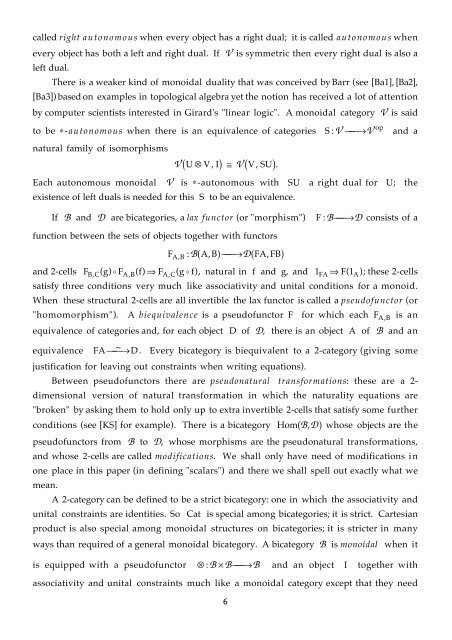Frobenius monads and pseudomonoids Introduction - ResearchGate
Frobenius monads and pseudomonoids Introduction - ResearchGate
Frobenius monads and pseudomonoids Introduction - ResearchGate
Create successful ePaper yourself
Turn your PDF publications into a flip-book with our unique Google optimized e-Paper software.
called right autonomous when every object has a right dual; it is called autonomous when<br />
every object has both a left <strong>and</strong> right dual. If V is symmetric then every right dual is also a<br />
left dual.<br />
There is a weaker kind of monoidal duality that was conceived by Barr (see [Ba1], [Ba2],<br />
[Ba3]) based on examples in topological algebra yet the notion has received a lot of attention<br />
by computer scientists interested in Girard's "linear logic". A monoidal category V is said<br />
to be *-autonomous when there is an equivalence of categories S<br />
natural family of isomorphisms<br />
( ) @ ( )<br />
V U V I V V SU<br />
ƒ , , .<br />
op<br />
:V æ æÆV <strong>and</strong> a<br />
Each autonomous monoidal V is *-autonomous with SU a right dual for U; the<br />
existence of left duals is needed for this S to be an equivalence.<br />
If B <strong>and</strong> D are bicategories, a lax functor (or "morphism")<br />
function between the sets of objects together with functors<br />
( ) æ Æ ( )<br />
FAB , : B A, B D FA, FB<br />
F:B D<br />
æÆ æ consists of a<br />
<strong>and</strong> 2-cells FBC , ( g) oFAB , ( f) fi FAC , ( gof) , natural in f <strong>and</strong> g, <strong>and</strong> 1FA fi F(<br />
1A);<br />
these 2-cells<br />
satisfy three conditions very much like associativity <strong>and</strong> unital conditions for a monoid.<br />
When these structural 2-cells are all invertible the lax functor is called a pseudofunctor (or<br />
"homomorphism"). A biequivalence is a pseudofunctor F for which each FAB , is an<br />
equivalence of categories <strong>and</strong>, for each object D of D, there is an object A of B <strong>and</strong> an<br />
equivalence FA æ ~ ÆD.<br />
Every bicategory is biequivalent to a 2-category (giving some<br />
justification for leaving out constraints when writing equations).<br />
Between pseudofunctors there are pseudonatural transformations: these are a 2dimensional<br />
version of natural transformation in which the naturality equations are<br />
"broken" by asking them to hold only up to extra invertible 2-cells that satisfy some further<br />
conditions (see [KS] for example). There is a bicategory Hom BD , ( ) whose objects are the<br />
pseudofunctors from B to D, whose morphisms are the pseudonatural transformations,<br />
<strong>and</strong> whose 2-cells are called modifications. We shall only have need of modifications in<br />
one place in this paper (in defining "scalars") <strong>and</strong> there we shall spell out exactly what we<br />
mean.<br />
A 2-category can be defined to be a strict bicategory: one in which the associativity <strong>and</strong><br />
unital constraints are identities. So Cat is special among bicategories; it is strict. Cartesian<br />
product is also special among monoidal structures on bicategories; it is stricter in many<br />
ways than required of a general monoidal bicategory. A bicategory B is monoidal when it<br />
is equipped with a pseudofunctor<br />
ƒ : B ¥ B æ æÆB<br />
<strong>and</strong> an object I together with<br />
associativity <strong>and</strong> unital constraints much like a monoidal category except that they need<br />
6
















